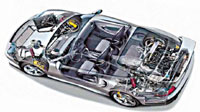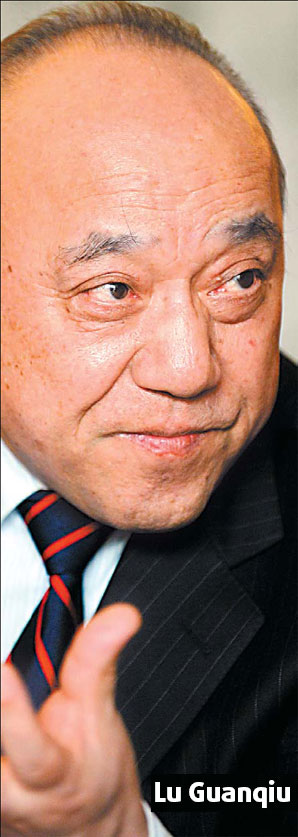

What impresses people most about Lu Guanqiu, China's auto component tycoon, is his hearty laugh and large nose.
In fact the 63-year-old billionaire has long had a keen nose for business.

Lu, founder and chairman of Wanxiang Group, turned a farm machinery workshop four decades ago into China's largest auto parts manufacturer with 40 billion yuan in sales last year. The company produces bumpers, bearings, joints and transmission parts for carmakers including General Motors, Ford, Chrysler, and Toyota.
Lu rose from a farm boy in Zhejiang province into one of the country's wealthiest men. He has been ranked as one of the 10 richest Chinese businessmen for six consecutive years since 2000 on Forbes magazine's annual "China Rich" list.
Wanxiang's success is fueled by China's unbridled auto consumption. The country's auto market, the world's second largest but the fastest growing, has maintained a double-digit growth rate for 10 consecutive years.
But Lu is not satisfied with just the Chinese market. While other mainland companies are content to stay at home or possibly build their business through exports, Wanxiang is pioneering a more aggressive approach.
"The first step was to sell our products in other countries," Lu says. "The second is to cooperate with foreign companies, sometimes by becoming the controlling shareholder, to enlarge our share in the mainstream international market."
Lu is helping write a new chapter in the story of China's economic growth by swooping into the US rust belt and scooping up investments in hard-hit auto supply manufacturers that are suffering from intensified competition and high operating costs. Wangxiang's latest deal is the acquisition of a driveshaft manufacturing business owned by Ford Motor Co.
Ford, the second biggest US automaker, completed the sale at the year's beginning to Neapco LLC, a Pennsylvania-based affiliate of Wangxiang Group. The manufacturing business will be moved from Monroe, Michigan, to Neapco's new factory in Detroit. The acquired plant is expected to bring $300-400 million annual sales when running on full capacity, Neapco says.
Industry analysts say there will be many acquisition opportunities in the US as Ford, General Motors and Chrysler spin off more non-core businesses to cut costs.
While Chinese enterprises like Lenovo and China National Offshore Oil Corporation (CNOOC) made news headlines around the world for their overseas acquisitions, Wanxiang has already been quietly weaving an overseas network years ahead of its peers by acquiring stakes in 19 overseas companies in eight countries, including the United States, the United Kingdom, Canada, Mexico and Brazil. Many of these companies used to be Wanxiang's clients. Wanxiang America Inc, incorporated in Chicago in 1994, has become the largest Chinese-invested company in the central and western parts of the US.
Resource allocation
Why doesn't Wanxiang just produce in China and export to the US?
"It's all about efficient allocation of resources and optimizing strength," Lu says in the strong local accent of Xiaoshan, a town next to Hangzhou.
"What do you have? What do I have? Let's combine what we have and we can create something big," Lu says.
Due to high production costs in the US, Wanxiang moves part of the manufacturing processes to China while the acquired US companies focus on processing and assembly and the Chinese factories are producing at lower costs for the US businesses. With stronger R&D and designing capabilities, the US firms are also able to shift their focus from manufacturing to providing technology services.
"It is a win-win solution for both the US and the Chinese companies," Lu says. "Because of such optimized allocation of resources, Wanxiang's acquisitions in the US have maintained an average investment return rate of over 100 percent. Wanxiang's exports also achieved average annual growth rate of 46 percent in the past 10 years," he adds.
Though Wanxiang's technology and quality may not be on the international forefront and it can't beat the cheaper prices of China's small factories, it maintains its leading position in the Chinese auto parts industry.
Lu says his secret recipe is finding what is beneficial to the targeted company.
"You must find how they can benefit from the partnership," Lu says. "We don't cut jobs. In fact we create extra employment."
Local governments in the US have welcomed Wanxiang America for saving manufacturing jobs. The Illinois government has proclaimed August 12 Wanxiang Day and Michigan offered the company substantial subsidies.
Integration
But clinching an acquisition deal is only the first step. How to integrate the new entity into the overall business operation and generate extra value is the challenge facing every Chinese executive exploring overseas acquisitions, let alone Lu, who only had middle school education and doesn't speak a word of English. In fact, he even cannot speak Mandarin.
Lu's answer is using the right people and localizing the businesses.

Ni Pin, who is Lu's son-in-law, established Wanxiang America 14 years ago when he was a Chinese student pursuing a PhD degree in the US. Ni started the business with only $20,000.
Like his boss, Ni pinched pennies to keep costs down as the company grew. He and his two other salespeople could drive forklifts so they could help unload container trucks. His wife, Lu's youngest daughter, was the company cleaning lady. When traveling on business, Ni slept at budget motels charging only about $19 per night
"Wanxiang America established its foothold because of credibility and honesty," Ni recalls.
Ni once got a $30,000 check from a client, the biggest deal Wanxiang realized in the US. But before he put the money into the bank, the client called and asked to return the product because it did not match its requirement. Ni drove seven hours that night and returned the check to the client and promised he would not receive one cent unless the problem was solved. The client later became a loyal partner of Wanxiang and five years later even transferred 51 percent of its stakes to Wanxiang for free.
Wanxiang began gobbling up US companies in the late 1990s.
Wanxiang's overseas companies adopted localized management systems from the start.
The companies had management standards aligned with international practices, with accounting and legal functions performed by local accounting and law firms. So they gained trust from local clients.
Among the over-1,000 employees of Wanxiang America, only six were dispatched from China, with all the rest hired locally. When Li Zhaoxing, former Chinese Minister of Foreign Affairs, visited the company, he joked, "I can see you have a United Nations here."
Lu says dispatching Chinese employees could create higher indirect costs because they need time to get familiar with the local environment and it would take them one or two years to independently take up responsibilities. Hiring locals means higher direct costs, but they know the laws, the culture and the market. It would be much easier for them to communicate with clients, with better opportunities of success.
Wanxiang America also uses local financing. Its fast growth has attracted the attention from local banks. They not only provide capital but also offer suggestions on the development of the company. Wanxiang America has established long-term relations with Citibank and Merrill Lynch. The company launched a "Wanxiang manufacturing fund" in 2003 and initially raised $30 million from local political and business figures.
(China Daily 04/14/2008 page12)













